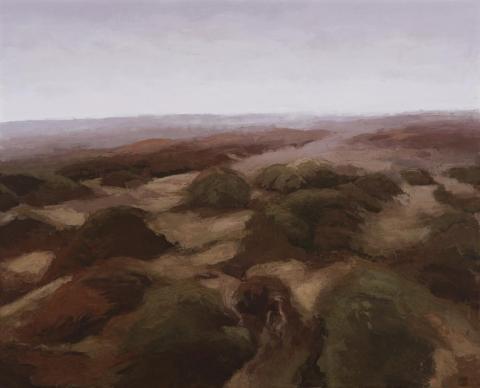VANISHING POINT NO. 6, 1995
PHILIP WOLFHAGEN
oil and beeswax on linen
169.0 x 208.5 cm
signed with initial, dated and inscribed lower right: W‘95 / SEPT. / “VANISHING POINT / NO. 6”
Sherman Galleries, Sydney
Private collection, Sydney
Sydney Grammar School, Sydney, November 1995
This painting was executed when Wolfhagen was Fellow in Art at Sydney Grammar School in 1995. He painted three 'Vanishing Point' works during that time, July-December 1995. At the end of his time there he held an exhibition at the school showing the works which were then sold through Sherman Galleries.
The location of the work is the Tasmanian Central Plateaux near the Walls of Jerusalem.
A vanishing point in landscape painting is a shifting and uncertain thing. Necessary to the successful construction of depth, vanishing points are the place of convergence where shapes and planes meet and are more often felt by the viewer than known. The more you look for that elusive point, the less certain you become.
Philip Wolfhagen's interest in the landscape has been an enduring one. From his early exhibitions in the 1990s to his current practice he has unwaveringly focused on the Tasmanian landscapes of his childhood. Always painted in the studio, sometimes with the assistance of photographs for reference, selecting the exact motif is a difficult process for the artist. In an interview Wolfhagen explained, 'Ninety-nine pictures will just be mundane and for me that is so difficult because I search for material all the time and finding it is one of the most painful parts of the whole process. People often say: 'Where did you paint this painting? Where is it?' I say, well, it doesn't really matter where, it could be anywhere; it's just a landscape. It's the connection to the work that interests me.'1
With its thickly applied mix of oil paint and bees wax, Vanishing Point No.6 has the subdued palette and diffuse light for which the painter's works are so keenly sought. The heath stretches out before us, meeting the dove-grey sky at an horizon line which dips and shifts as though subject to atmospheric pressure; the composition's vanishing point seemingly behind the hillock to our right.
Exploring the same, unrelenting motifs of sky, clouds, sea and plains, John McDonald notes,'For Wolfhagen, the challenge was to combine the unchanging, classical elements of the landscape with the untidiness of shrubs and trees that grow each year in disorderly profusion. Even though there are no figures in these paintings, the trees act as a metaphor for the brevity of human life and aspirations set against the great canvas of the natural world. In the expansiveness of that view we become conscious of our own smallness.'2
1. Speed, A.,'Tasmanian artist Philip Wolfhagen in a true natural', The Australian, 15 October 2011
2. McDonald, J., 'Philip Wolfhagen', Australian Art Collector, Issue 51, January - March 2010, p.202
MERRYN SCHRIEVER
